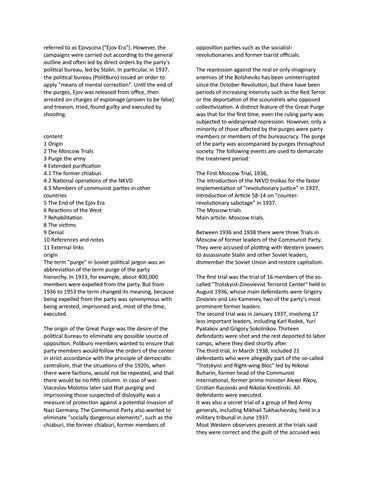referred to as Ejovșcina ("Ejov Era"). However, the campaigns were carried out according to the general outline and often led by direct orders by the party's political bureau, led by Stalin. In particular, in 1937, the political bureau (PolitBuro) issued an order to apply "means of mental correction". Until the end of the purges, Ejov was released from office, then arrested on charges of espionage (proven to be false) and treason, tried, found guilty and executed by shooting. content 1 Origin 2 The Moscow Trials 3 Purge the army 4 Extended purification 4.1 The former chiaburi 4.2 National operations of the NKVD 4.3 Members of communist parties in other countries 5 The End of the Ejov Era 6 Reactions of the West 7 Rehabilitation 8 The victims 9 Denial 10 References and notes 11 External links origin The term "purge" in Soviet political jargon was an abbreviation of the term purge of the party hierarchy. In 1933, for example, about 400,000 members were expelled from the party. But from 1936 to 1953 the term changed its meaning, because being expelled from the party was synonymous with being arrested, imprisoned and, most of the time, executed. The origin of the Great Purge was the desire of the political bureau to eliminate any possible source of opposition. Poliburo members wanted to ensure that party members would follow the orders of the center in strict accordance with the principle of democratic centralism, that the situations of the 1920s, when there were factions, would not be repeated, and that there would be no fifth column. in case of war. Viaceslav Molotov later said that purging and imprisoning those suspected of disloyalty was a measure of protection against a potential invasion of Nazi Germany. The Communist Party also wanted to eliminate "socially dangerous elements", such as the chiaburi, the former chiaburi, former members of
opposition parties such as the socialistrevolutionaries and former tsarist officials. The repression against the real or only imaginary enemies of the Bolsheviks has been uninterrupted since the October Revolution, but there have been periods of increasing intensity such as the Red Terror or the deportation of the scoundrels who opposed collectivization. A distinct feature of the Great Purge was that for the first time, even the ruling party was subjected to widespread repression. However, only a minority of those affected by the purges were party members or members of the bureaucracy. The purge of the party was accompanied by purges throughout society. The following events are used to demarcate the treatment period: The First Moscow Trial, 1936, The introduction of the NKVD troikas for the faster implementation of "revolutionary justice" in 1937, Introduction of Article 58-14 on "counterrevolutionary sabotage" in 1937. The Moscow trials Main article: Moscow trials. Between 1936 and 1938 there were three Trials in Moscow of former leaders of the Communist Party. They were accused of plotting with Western powers to assassinate Stalin and other Soviet leaders, dismember the Soviet Union and restore capitalism. The first trial was the trial of 16 members of the socalled "Trotskyist-Zinovievist Terrorist Center" held in August 1936, whose main defendants were Grigory Zinoviev and Lev Kamenev, two of the party's most prominent former leaders. The second trial was in January 1937, involving 17 less important leaders, including Karl Radek, Yuri Pyatakov and Grigory Sokolnikov. Thirteen defendants were shot and the rest deported to labor camps, where they died shortly after. The third trial, in March 1938, included 21 defendants who were allegedly part of the so-called "Trotskyist and Right-wing Bloc" led by Nikolai Buharin, former head of the Communist International, former prime minister Alexei Rîkov, Cristian Racovski and Nikolai Krestinski. All defendants were executed. It was also a secret trial of a group of Red Army generals, including Mikhail Tukhachevsky, held in a military tribunal in June 1937. Most Western observers present at the trials said they were correct and the guilt of the accused was

